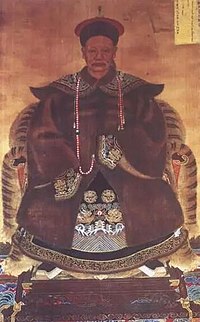Hooge, Prince Su
| Hooge | |||||||||
|---|---|---|---|---|---|---|---|---|---|
| Prince Su of the First Rank | |||||||||
 | |||||||||
| Prince Su of the First Rank | |||||||||
| Tenure | 1636–1648 | ||||||||
| Successor | Fushou | ||||||||
| Born | 16 April 1609 | ||||||||
| Died | 4 May 1648 (aged 39) | ||||||||
| Consorts | Lady Hada Nara (died 1636)Borjigit Duleima (m. 1636) | ||||||||
| Issue | Qizheng'e Gutai Wohena Fushou, Prince Xianque of the First Rank Mengguan, Prince Wenliang of the Second Rank Xingbao Shushu | ||||||||
| |||||||||
| House | Aisin Gioro | ||||||||
| Father | Hong Taiji | ||||||||
| Mother | Consort Ji (Hong Taiji) | ||||||||
| Hooge | |||||||||
|---|---|---|---|---|---|---|---|---|---|
| Chinese | 豪格 | ||||||||
| |||||||||
Hooge (Manchu: ![]() ; 16 April 1609 – 4 May 1648), formally known as Prince Su, was a Manchu prince of the Qing dynasty. He was the eldest son of Hong Taiji, the second ruler of the Qing dynasty.
; 16 April 1609 – 4 May 1648), formally known as Prince Su, was a Manchu prince of the Qing dynasty. He was the eldest son of Hong Taiji, the second ruler of the Qing dynasty.
Life[]
Hooge was born in the Aisin Gioro clan as the eldest son of Hong Taiji, the second ruler of the Qing dynasty. His mother was Lady Ula Nara, one of Hong Taiji's consorts.
Hooge participated in military campaigns against the Mongols, Koreans and the Ming dynasty. After Hong Taiji's death in 1643, Hooge and his uncle Dorgon fought over the succession to the throne. The situation was to Hooge's advantage because three of the Eight Banners previously under Hong Taiji's control had been passed on to him. On the other hand, Dorgon had the support of his brothers and two White Banners. This meant that the remaining two Red Banners controlled by Daišan and his son, as well as the Bordered Blue Banner under Chiurhala, were crucial to ensuring that Hooge could win the succession. After much dispute, Daišan started favouring Hooge, who ostensibly refused to take the throne. Hooge was actually waiting for others to urge him to take the throne, so that he could sit on it without projecting a power-hungry image of himself. Unfortunately for Hooge, Dorgon and his brothers gave way, so the conflict continued without a solution. The power struggle concluded with a compromise in order to avoid internal strife. Dorgon nominated Fulin, another son of Hong Taiji born to Consort Zhuang, to be the new ruler, so Fulin ascended to the throne as the Shunzhi Emperor.
Even after the Shunzhi Emperor came to power, there was still much friction between Hooge and Dorgon. According to popular belief, Hooge had conceived a scheme to seize the throne from the Shunzhi Emperor, but he leaked out his plan to Dorgon's brother Dodo, who informed Dorgon about it. Dorgon then used this as an excuse to have Hooge arrested and thrown into prison. However historical records state that Hooge was imprisoned after the Qing government launched military campaigns against remnant rebel forces in western China, and he died during his incarceration. He was posthumously rehabilitated in 1650, two years after his death.
Family[]
Parents:
- Father: Hong Taiji, Emperor Wen of the Aisin Gioro clan (皇太極 文皇帝 愛新覺羅氏)
- Mother: Consort Ji of the Ula Nara clan (繼妃 烏拉那拉氏)
Consorts and Issue:
- Primary consort, of the Hada Nara clan (嫡福晉 哈達那拉氏; d. 1636)
- Primary consort, of the Khorchin Borjigit clan (嫡福晉 博爾濟吉特氏), personal name Duleima (杜勒瑪)
- , Prince Xianque of the First Rank (顯愨親王 富綬; 2 July 1643 – 11 January 1670), fourth son
- Secondary consort, of the Shuolongwu clan (側福晉 碩隆武氏)
- Mengguan, Prince Wenliang of the Second Rank (溫良郡王 猛瓘; 21 December 1643 – 12 August 1674), fifth son
- Mistress, of the Nara clan (那拉氏)
- Qizheng'e (齊正額; 16 November 1634 – March/April 1677), first son
- Mistress, of the Huang clan (黃氏; d. 1648)
- Gutai, General of the Second Rank (輔國將軍 固泰; 13 March 1638 – 18 August 1701), second son
- Wohena, General of the Second Rank (輔國將軍 握赫納; 7 March 1639 – 24 October 1662), third son
- Mistress, of the Ningguta clan (寧古塔氏)
- Xingbao (星保; 26 December 1643 – 16 May 1686), sixth son
- Mistress, of the Sirin Gioro clan (西林觉罗氏), daughter of Tai'erkang (泰尔康)
- Mistress, of the Irgen Gioro clan (伊爾根覺羅氏)
- Shushu (舒書; 22 February 1645 – 2 November 1685), seventh son
- Unknown
- A daughter who married Geng Jingzhong (1644–1682)
Ancestry[]
| Giocangga (1526–1583) | |||||||||||||||||||
| Taksi (1543–1583) | |||||||||||||||||||
| Empress Yi | |||||||||||||||||||
| Nurhaci (1559–1626) | |||||||||||||||||||
| Agu | |||||||||||||||||||
| Empress Xuan (d. 1569) | |||||||||||||||||||
| Hong Taiji (1592–1643) | |||||||||||||||||||
| Taicu | |||||||||||||||||||
| Yangginu (d. 1584) | |||||||||||||||||||
| Empress Xiaocigao (1575–1603) | |||||||||||||||||||
| Hooge (1609–1648) | |||||||||||||||||||
| Tailan | |||||||||||||||||||
| Buyan | |||||||||||||||||||
| Bokdo (d. 1607) | |||||||||||||||||||
| Consort Ji (Hong Taiji) | |||||||||||||||||||
See also[]
- Prince Su
- Prince Wen
- Royal and noble ranks of the Qing dynasty
- Ranks of imperial consorts in China#Qing
References[]
- Zhao, Erxun (1928). Draft History of Qing (Qing Shi Gao). Vol. 219. China.
- Hummel, Arthur W. Sr., ed. (1943). . Eminent Chinese of the Ch'ing Period. United States Government Printing Office.
- Qing dynasty imperial princes
- Manchu politicians
- 1609 births
- 1648 deaths
- Qing dynasty politicians
- Prince Su
- Hong Taiji's sons